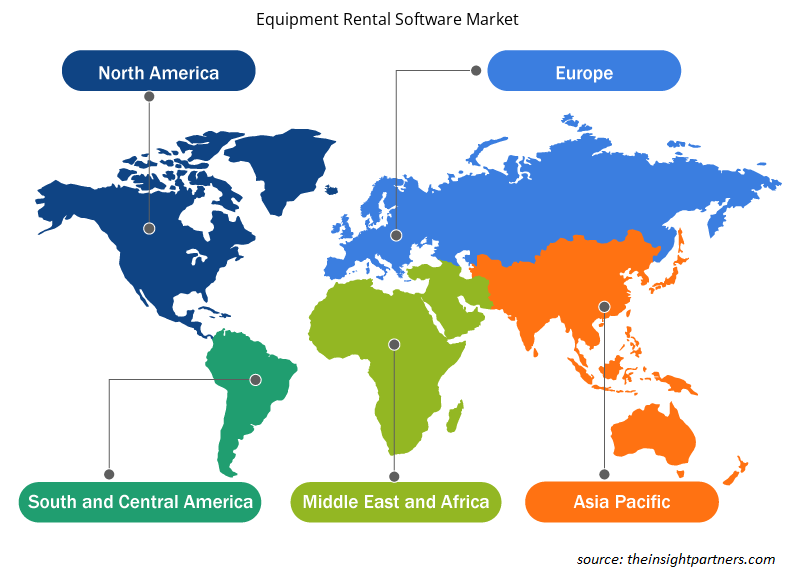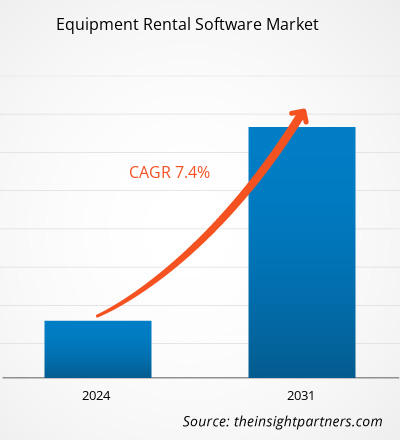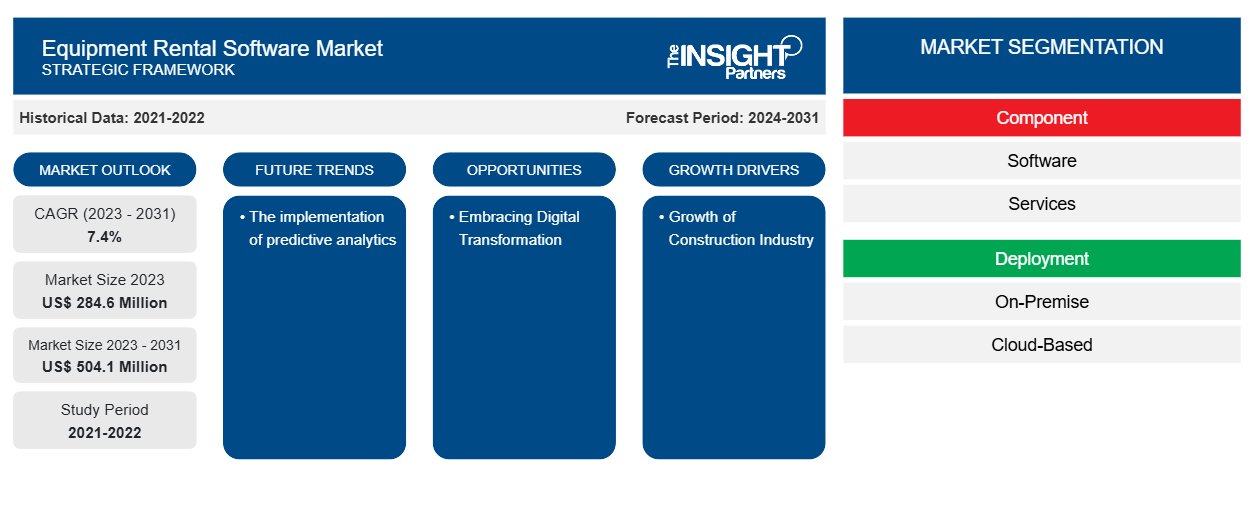Si prevede che la dimensione del mercato del software per il noleggio di attrezzature raggiungerà i 504,1 milioni di dollari entro il 2031, rispetto ai 284,6 milioni di dollari del 2023. Si prevede che il mercato registrerà un CAGR del 7,4% nel periodo 2023-2031. È probabile che l'implementazione dell'analisi predittiva rimanga una tendenza chiave nel mercato.CAGR of 7.4% during 2023–2031. The implementation of predictive analytics is likely to remain a key trend in the market.
Analisi di mercato del software per il noleggio di attrezzature
Il software per il noleggio di attrezzature è progettato per utilizzare in modo efficiente le risorse disponibili, assicurando al contempo che ogni aspetto dell'attività sia coperto, dalla formazione e assistenza clienti alla produttività e gestione finanziaria. Lo scopo del software per il noleggio di attrezzature è quello di aiutare a gestire la flotta di attrezzature di proprietà di un'organizzazione. Questo software può apportare vantaggi a un'organizzazione oltre a sapere cosa è disponibile e dove si trova il noleggio. Un software per il noleggio di attrezzature potente consentirà a un'organizzazione di fare quanto segue e di raccogliere i benefici. Il vantaggio di tutte queste funzionalità, nel complesso, è un aumento della produttività e della redditività. La differenza tra un buon software per il noleggio di attrezzature e il miglior software per il noleggio di attrezzature è la profondità e l'usabilità delle sue funzionalità. HBS Systems va oltre le funzionalità di base del software per il noleggio di attrezzature con una serie di funzionalità aggiuntive che possono essere utilizzate ovunque su dispositivi mobili in un unico sistema facile da usare .
Panoramica del mercato del software per il noleggio di attrezzature
Il software di noleggio attrezzature fornisce alle aziende strumenti per semplificare i processi, organizzare le operazioni, gestire le risorse e calcolare l'ammortamento. Utilizzando questa soluzione software, è anche possibile assegnare attrezzature ai dipendenti, pianificare la manutenzione ed eseguire operazioni di back-office come contabilità e tenuta dei registri contabili. Il software di noleggio attrezzature può aiutare il mercato medio e le piccole imprese in rapida crescita a raggiungere i propri obiettivi aziendali e a crescere attraverso vantaggi quali la riduzione dei tempi di fermo delle attrezzature, l'organizzazione delle pianificazioni, la generazione di report e approfondimenti, la gestione di fatture e documenti e altro.
Personalizza questo report in base alle tue esigenze
Riceverai la personalizzazione gratuita di qualsiasi report, comprese parti di questo report, o analisi a livello nazionale, pacchetto dati Excel, oltre a usufruire di grandi offerte e sconti per start-up e università
- Scopri le principali tendenze di mercato in questo rapporto.Questo campione GRATUITO includerà analisi di dati che spaziano dalle tendenze di mercato alle stime e alle previsioni.
Driver e opportunità del mercato del software per il noleggio di attrezzature
Crescita del settore delle costruzioni per favorire il mercato
I progetti di investimento pubblico stanno dando una grande spinta al settore edile. Ciò include mega-progetti in settori quali infrastrutture urbane, trasporti, strade, irrigazione e immobiliare. L'Autorità aeroportuale indiana sta investendo 7,3 miliardi di dollari nella costruzione di nuovi aeroporti, nell'ampliamento e nell'ammodernamento di quelli esistenti e nel rafforzamento di piste, blocchi tecnici e torri di controllo. Amplierà inoltre i tre aeroporti PPP di Delhi, Bengaluru e Hyderabad, con un investimento di 3,59 miliardi di dollari entro il 2025. Il software di noleggio di attrezzature edili per l'industria dei materiali da costruzione garantisce una soluzione affidabile e sicura che soddisfi le esigenze dei clienti. Con funzionalità specifiche quali prezzi delle attrezzature industriali, manutenzione preventiva, gestione dei numeri di serie e moduli di riparazione, Sirius-e è stato progettato per soddisfare tutte le esigenze del noleggio di utensili e attrezzature. La capacità di Sirius-e di gestire noleggi, vendite e assistenza in un unico software di noleggio integrato porterà notevoli vantaggi alla tua attività di noleggio edile.PPP airports in Delhi, Bengaluru, and Hyderabad, with an investment of US $3.59 billion by 2025. Construction material industry construction equipment rental software ensures that you have a reliable and reliable solution that meets clients' needs. With specific features such as industrial equipment pricing, preventive maintenance, serial number management, and repair modules, Sirius-e was designed to meet all the needs of tool and equipment rental. Sirius-e’s ability to handle rentals, sales, and service all in one integrated rental software will bring significant benefits to your construction rental business.
Abbracciare la trasformazione digitale
L'avvento delle tecnologie digitali offre opportunità senza precedenti alle aziende di noleggio di attrezzature per semplificare le operazioni, migliorare le esperienze dei clienti e guidare la crescita. L'adozione di iniziative di trasformazione digitale, come sistemi di gestione del noleggio basati su cloud, tracciamento delle attrezzature abilitato per IoT e applicazioni mobili per l'interazione con i clienti, consente alle aziende di rimanere all'avanguardia. Sfruttando l'analisi dei dati e le informazioni predittive, le aziende possono ottimizzare l'allocazione delle risorse, anticipare le esigenze dei clienti e prendere decisioni aziendali informate. Microsoft Dynamics 365 Business Central può essere una soluzione preziosa per le aziende di noleggio di attrezzature, fornendo una piattaforma integrata per gestire in modo efficiente vari aspetti delle loro operazioni aziendali.IoT-enabled equipment tracking, and mobile applications for customer engagement, enables businesses to stay ahead of the curve. By leveraging data analytics and predictive insights, businesses can optimize resource allocation, anticipate customer needs, and make informed business decisions. Microsoft Dynamics 365 Business Central can be a valuable solution for equipment rental companies, providing an integrated platform to manage various aspects of their business operations efficiently.
Analisi della segmentazione del rapporto di mercato del software per il noleggio di attrezzature
I segmenti chiave che hanno contribuito alla derivazione dell'analisi di mercato del software per il noleggio di attrezzature sono i componenti, l'implementazione, le dimensioni dell'organizzazione e l'utente finale.
- In base alla componente, il mercato del software per il noleggio di attrezzature si divide in software e servizi.
- In base all'implementazione, il mercato è segmentato in on-premise e basato su cloud.
- In base alle dimensioni dell'organizzazione, il mercato è segmentato in piccole e medie imprese e grandi imprese.
- In termini di utenti finali, il mercato è segmentato in produzione, edilizia, trasporti e altri.
Analisi della quota di mercato del software per il noleggio di attrezzature per area geografica
L'ambito geografico del rapporto di mercato del software per il noleggio di attrezzature è principalmente suddiviso in cinque regioni: Nord America, Asia Pacifico, Europa, Medio Oriente e Africa e Sud e Centro America. Le crescenti attività di costruzione in Nord America e la crescente necessità di operazioni efficienti tra le aziende stanno guidando la crescita del mercato. Vari attori in Nord America stanno lanciando software per il noleggio di attrezzature. Ad esempio, a settembre 2020, Orion Software ha annunciato un accordo con Telus per vendere e commercializzare la tecnologia GPS per integrare i suoi servizi di noleggio. Le società di noleggio possono utilizzare la piattaforma Sirius e per aggiornare i loro contatori in tempo reale, fatturando l'eccesso di utilizzo e attivando avvisi di manutenzione preventiva. Il portale Web del portale clienti può anche localizzare le attrezzature sul campo in un cantiere. Questa integrazione con la tecnologia Telus offre un significativo vantaggio di distribuzione. Le società di noleggio possono ottenere una tecnologia standard che funziona su tutte le marche di attrezzature ed è molto semplice da installare.Telus to sell and commercialize GPS technology to supplement its rental services. Rental companies can use the Sirius e platform to update their meters in real time, invoicing overuse and triggering preventive maintenance alerts. The customer portal's web portal can also locate equipment in the field on a construction site. This integration with Telus technology provides a significant deployment benefit. Rental companies can get a standard technology that works on all equipment brands and is very simple to install.
Approfondimenti regionali sul mercato del software per il noleggio di attrezzature
Le tendenze regionali e i fattori che influenzano il mercato del software per il noleggio di attrezzature durante il periodo di previsione sono stati ampiamente spiegati dagli analisti di Insight Partners. Questa sezione discute anche i segmenti e la geografia del mercato del software per il noleggio di attrezzature in Nord America, Europa, Asia Pacifico, Medio Oriente e Africa e America meridionale e centrale.

- Ottieni i dati specifici regionali per il mercato del software di noleggio attrezzature
Ambito del rapporto di mercato sul software per il noleggio di attrezzature
| Attributo del report | Dettagli |
|---|---|
| Dimensioni del mercato nel 2023 | 284,6 milioni di dollari USA |
| Dimensioni del mercato entro il 2031 | 504,1 milioni di dollari USA |
| CAGR globale (2023-2031) | 7,4% |
| Dati storici | 2021-2022 |
| Periodo di previsione | 2024-2031 |
| Segmenti coperti | Per componente
|
| Regioni e Paesi coperti | America del Nord
|
| Leader di mercato e profili aziendali chiave |
|
Densità dei player del mercato del software per il noleggio di attrezzature: comprendere il suo impatto sulle dinamiche aziendali
Il mercato del software per il noleggio di attrezzature sta crescendo rapidamente, spinto dalla crescente domanda degli utenti finali dovuta a fattori quali l'evoluzione delle preferenze dei consumatori, i progressi tecnologici e una maggiore consapevolezza dei vantaggi del prodotto. Con l'aumento della domanda, le aziende stanno ampliando le loro offerte, innovando per soddisfare le esigenze dei consumatori e capitalizzando sulle tendenze emergenti, il che alimenta ulteriormente la crescita del mercato.
La densità degli operatori di mercato si riferisce alla distribuzione di aziende o società che operano in un particolare mercato o settore. Indica quanti concorrenti (operatori di mercato) sono presenti in un dato spazio di mercato in relazione alle sue dimensioni o al valore di mercato totale.
Le principali aziende che operano nel mercato del software per il noleggio di attrezzature sono:
- BCS Prosoft, LLC
- Prenotabile eSlJB Inc.
- Noleggio EZ
- Software di noleggio HQ
- inspHire Ltd.
- Società anonima
Disclaimer : le aziende elencate sopra non sono classificate secondo un ordine particolare.

- Ottieni la panoramica dei principali attori del mercato del software per il noleggio di attrezzature
Notizie e sviluppi recenti sul mercato del software per il noleggio di attrezzature
Il mercato del software per il noleggio di attrezzature viene valutato raccogliendo dati qualitativi e quantitativi dopo la ricerca primaria e secondaria, che include importanti pubblicazioni aziendali, dati associativi e database. Di seguito sono elencati alcuni degli sviluppi nel mercato del software per il noleggio di attrezzature:
- EZRentOut ha introdotto una serie di nuove funzionalità e miglioramenti. Gli affitti alle aziende sono semplificati con il modulo di gestione dei clienti B2B. I clienti possono ora utilizzare un pulsante Quick Check-in per resi più rapidi ed efficienti, addebitare tariffe di noleggio in base a quanto è stato utilizzato il bene e aggiungere grafici/grafici da Custom Reports direttamente alla Dashboard, tra le altre funzionalità. (Fonte: EZRentOut, marzo 2022)
- Point of Rental Software ha ampliato le sue attività in Sud Africa, poiché questa è una delle strategie di crescita dell'azienda; l'azienda punta a soluzioni software di business intelligence nell'Africa subsahariana. (Fonte: Point of Rental Software, dicembre 2021)
Copertura e risultati del rapporto sul mercato del software per il noleggio di attrezzature
Il rapporto "Dimensioni e previsioni del mercato del software per il noleggio di attrezzature (2021-2031)" fornisce un'analisi dettagliata del mercato che copre le seguenti aree:
- Dimensioni e previsioni del mercato del software per il noleggio di attrezzature a livello globale, regionale e nazionale per tutti i principali segmenti di mercato coperti dall'ambito
- Tendenze del mercato del software per il noleggio di attrezzature e dinamiche di mercato come conducenti, restrizioni e opportunità chiave
- Analisi dettagliata delle cinque forze PEST/Porter e SWOT
- Analisi di mercato del software per il noleggio di attrezzature che copre le principali tendenze del mercato, il quadro globale e regionale, i principali attori, le normative e i recenti sviluppi del mercato
- Analisi del panorama industriale e della concorrenza che copre la concentrazione del mercato, l'analisi della mappa di calore, i principali attori e gli sviluppi recenti per il mercato del software di noleggio attrezzature
- Profili aziendali dettagliati
- Analisi storica (2 anni), anno base, previsione (7 anni) con CAGR
- Analisi PEST e SWOT
- Valore/volume delle dimensioni del mercato - Globale, Regionale, Nazionale
- Industria e panorama competitivo
- Set di dati Excel
Report recenti
Rapporti correlati
Testimonianze
Motivo dell'acquisto
- Processo decisionale informato
- Comprensione delle dinamiche di mercato
- Analisi competitiva
- Analisi dei clienti
- Previsioni di mercato
- Mitigazione del rischio
- Pianificazione strategica
- Giustificazione degli investimenti
- Identificazione dei mercati emergenti
- Miglioramento delle strategie di marketing
- Aumento dell'efficienza operativa
- Allineamento alle tendenze normative























 Ottieni un campione gratuito per - Mercato del software per il noleggio di attrezzature
Ottieni un campione gratuito per - Mercato del software per il noleggio di attrezzature